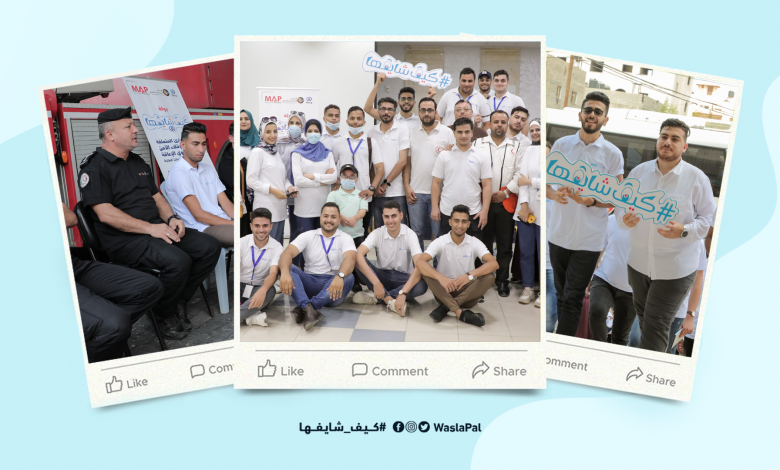Kaif Shaifha tour was launched for the second time between Gaza and the Central governorates

Kaif Shaifha tour was kicked off for the second time this year between Gaza and Central Governorates at several different stations, under the title of emergency mechanisms related to evacuation and safe accommodation for persons with disabilities during periods of aggression and emergency events. In that tour, 25 young men and women with and without disabilities from Wasla team participated on Thursday July 29, 2021. This tour was part of a set of activities implemented by the Social Development Forum in the Wasla program for the second year in a row.
The tour targeted three stations, including the Palestinian Civil Defense, the Palestinian Red Crescent Society, and the General Palestinian Federation for persons with Disabilities – the central and Gaza governorates. It aims these places because these parties play a key role in identifying the nature of the emergency plan developed during the safe evacuation of persons with disabilities in periods of aggression and emergency events and the mechanisms for its implementation, the extent to which safe accommodation has been achieved, the nature of the services provided by these entities to persons with disabilities at these times, and the extent to which information is easily accessible to them.
First stop; Palestinian Civil Defense – Gaza Governorate
The youth opened the first hearings and dialogue sessions with the Central Civil Defense Station. Colonel Raid Al-Dahshan, Director of Civil Defense Operations in Gaza Governorate, Major Ibrahim Abu Al-Reish, and Captain Alaa Al-Muaizi, Head of the Fire and Rescue Department, participated in the session. Then, the youth interviewed representatives of the Civil Defense about the extent their readiness to deal with persons with disabilities during the period of aggression. And the extent to which the emergency plan is compatible with all segments of society, including persons with disabilities, and the extent to which one of them is involved in designing emergency plans related to evacuation and safe accommodation during periods of aggression. In addition to live situations that occurred for crews with persons with disabilities. And the most difficult challenges and difficulties they face during the evacuation and shelter process.
The youth also submitted a set of queries, on top of which was the question of one of the participants in the tour, “Najwa Barika is a person with hearing disabilities,” as she wondered about the extent to which they are dealt with in emergency situations and the availability of people trained in the use of sign language in such cases, the youth also added other questions about on how to secure access the information for persons with disabilities in emergency situations? And the extent of updates to emergency plans, considering the Gaza Strip a hot area constantly exposed to wars.
At the conclusion of the first session, the young participants came up with a set of recommendations, including:
Work to intensify the expertise of civil defense teams to deal with persons with disabilities and give them the necessary training.
Emphasizing the importance of having a signal interpreter in the civil defense centers. In addition to align all civil defense centers and their equipment in proportion to persons with disabilities.
Harmonization of news releases and information issued by the civil defense during periods of aggression.
Let persons with disabilities participate in developing emergency plans.
Intensifying pressure on international institutions to provide the appropriate capabilities for Civil Defense
Providing a beeline for persons with disabilities. By this line they well are able to communicate by phone or through messages in times of war.
For his part, Colonel “Raed Al-Dahshan” stressed the need to raise the previous recommendations to them to work on them as soon as possible and present them to the concerned authorities, in order to avoid any problems when dealing with those people during periods of aggression if they occur in the future.
He stressed the role of young people in such activities and the extent of the importance of the topic of the tour and youth creativity in the process of community accountability and hearing sessions, and praised the efforts of the Social Developmental Forum and Wasla program staff for implementing such activities that greatly serve the community.
Second station; Palestinian Red Crescent Society – Gaza Governorate
Moving to the second stop of the tour, Kaif Shaifha, where the participants and Wasla team headed to the Palestinian Red Crescent Society in Gaza City, as it plays a key role in peace and war situations, as the society has a special unit in disaster management, and another in emergency and ambulance management, and hosted youth Ibrahim Abu al-Kas, an ambulance officer, a disaster management official, Abdul Aziz Abu Aisha, and an ambulance and emergency unit official, Alaa al-Sousi. During the session, the youth discussed the role of the Red Crescent during the war and the extent to which ambulances and their equipment were adapted to deal with persons with disabilities. The youth also interviewed representatives of the Crescent On the nature of the services provided by the Crescent during the same period to persons with disabilities, and the development of emergency plans in previous wars and their comparison with each other, the session also dealt with the role of the Crescent in coordination and networking with the concerned authorities during the period of aggression.
The youth inquired about a number of issues. For instance, including the participant, “Ghada Zomlot, who has visual disability “, inquired about the extent to which ambulance and safe transportation for persons with disabilities were secured during the aggression period. Many questions about the reasons for the poor adaptation of the shelters and the lack of privacy for persons with disabilities were also raised.
By the send of the second session, the participants came up with a set of recommendations for the Palestinian Red Crescent Society, which were as follows:
Putting pressure on international institutions and organizations to implement the provisions of international conventions for the protection of persons with disabilities in peace, war, and periods of emergency.
Adapting Red Crescent’s buildings and vehicles to suit with the needs of persons with disabilities.
Harmonization of the information published by the Red Crescent, whether in print or digital.
Training Red Crescent cadres on how to deal with persons with disabilities.
Let persons with disabilities participate in the development of emergency plans.
Working to provide an electronic application for people with disabilities, it ensures their access to the relevant authorities in times of aggression on the one hand, and secures the necessary information about events in emergency situations on the other hand.
Both Abu al-Kas and Abu Aisha welcomed these recommendations, stressing the need to send them to work on them and to consult them with the higher management to work on their implementation.
Abu Eisha explained that the emergency plan is always being worked on and developed, but the participation of young people in such activities enhances more than their work and helps shed light on such issues. He also stressed the need for future cooperation with various institutions that target the youth category with and without disabilities. Besides, they Obstacle to work together to advocate for societal issues in times of peace and war.
Third station; The General Palestinian Federation for Persons with Disabilities – Gaza and Central Governorates
As for the last stop, it was with the General Palestinian Union for Persons with Disabilities for the governorates of Gaza and the Central Governor where the youth interviewed each of; Abdul Kareim Al-Qarnawi, the chairman of the union in the Central Governor, Hassan Al-Zaalan, Chairman of the Board of Directors of the Union, Gaza Branch, and Naji, one of the participants in Wasla program and the Secretary of the Union in the Central branch. And the role they played in helping and securing the lives of persons with disabilities during that period, and the most prominent difficulties they faced, including the weak response of institutions to deal with them during the period of aggression, and the lack of material and financial capabilities to achieve the required action.
The youth approached the representatives of the Union by asking a set of questions, most notably the extent of the weak networking with institutions concerned with persons with disabilities in times of war. After the session, the youth came up with a set of recommendations, the most prominent of which are:
Intensifying pressure campaigns and advocating for the rights of persons with disabilities.
Developing the union’s social networking sites system as the best way to access services and information.
Continuously updating the emergency plan. This can be done by increasing cooperation with human rights institutions and the competent authorities in emergency situations.
General recommendations:
It is noteworthy that this tour came out with a set of general recommendations after visiting the three stations, which are as follows:
It is necessary to harmonize all devices and equipment that are used in evacuation and shelter operations with people with disabilities during the aggression period.
Work to rehabilitate and train all cadres that deal with persons with disabilities during the aggression and in emergency cases.
The necessity of working to involve persons with disabilities in the development of emergency and crisis plans.
Work to develop means of communication by including electronic applications that help persons with disabilities in safe access to all services and their needs during the period of aggression.
Strengthening the network of relations between all parties concerned with persons with disabilities and intensifying efforts to cooperate and coordinate among them to ensure assistance to the largest possible number of persons with disabilities during the aggression in the Gaza Strip.
In a related context, Walaa Karaja, the project coordinator, stressed that these recommendations will be submitted directly to the concerned authorities and work on them, stressing the importance of the tour, Kaif Shaifha, as an important tool of social accountability and the role it plays in enhancing the role of youth and strengthening their listening and dialogue skills with officials and decision makers.
Ibrahim Suwaidan also expressed his participation in the Kaif Shaifha tour, saying: One of the wonderful experiences I had in my life is Kaif Shaifha tour, we met several institutions and discussed with them the issues of persons with disabilities, especially during the period of aggression and times of crisis, and we made a set of recommendations, and it was a great cooperation by the concerned authorities, and we hope that all recommendations will be taken into consideration, in order to achieve the greatest possible level of equality and full participation in our society for persons with disabilities.
It is worth mentioning that the tour, Kaif Shaifha, is implemented by the Social Developmental Forum within the activities of the project to improve the local response to the rights of persons with disabilities “Wasla 2” in partnership with the Medical Aid Society for Palestinians (MAP).

